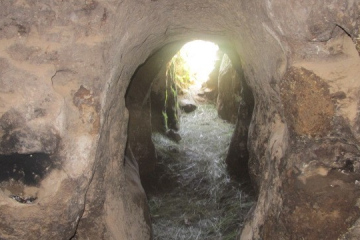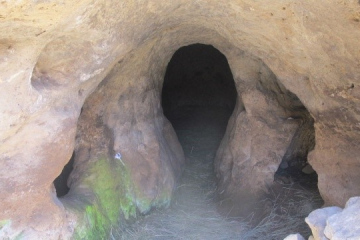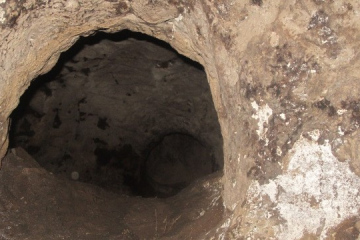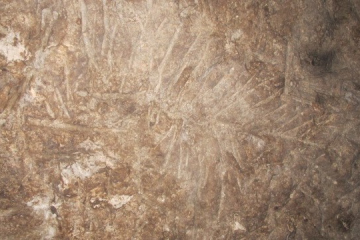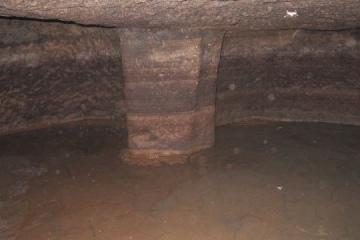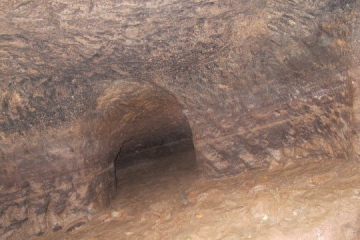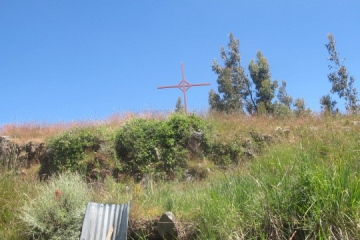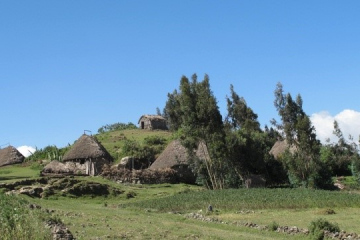Co-ordinates: 9° 30’.469’’ N, 39° 32’. 239’’ E
Location
(description by Deresse Ayenachew)
The Kwulä Wäyni area can be understood as a land of caves and megalithic monuments. It consists of large and small caves within the confines of a small village. The site is located in the district of Angolälla and Tära and situated 11kms east of Chachka town, the capital of the district, near the town of Debre Berhan. The Kwulä Wäyni locality is encircled to the east and south west by the River Amäja, the main water resource for the villages and the main water body of the Chacha River, tributary to the basin of the Blue Nile. Its altitude stands at 2700m and it is positioned at 9° 30’.469’’ north and 39° 32’. 239’’ East.
1. Yä-Näbäru caves
The Kwulä Wäyni cave called Yä-Näbäru serves as an impressive monumental presence of the Šäwan past. Hidden in a small rocky hill, the cave at first glance does not present its actual structure. Its eastern corridor serves as an entrance to the interior. Two holes, each 50cm deep, were hewn out on both sides at the start of the north-eastern corridor. Water drips through the rock filling the hole on the right. A few steps further brings one to the first chamber of the eastern corridor and then directly to a second chamber that immediately joins a two-meter long southern corridor. The second chamber displays two deep holes measuring more than 1.50m that were intended to hold human skeletal remains. These holes have circular covers, bearing witness to pre-Christian burial traditions in Ethiopia.
The third and last chamber presents the same arrangement, but with one hole. However, the third chamber is not only accessed through the two main corridors from the eastern and southern doors, but also has a special tunnel leading directly to it. This tunnel, dug out of the left side of the main corridor of the southern entry, is three meters long, 50cm wide and 30cm high. It was probably used as an alternative passage into the third chamber while also facilitating access to the other two chambers. It seems that the main entrances of the corridor were closed and that the tunnel was used for periodic entry into the chambers.
Crafts of the cave of Yä-Näbäru
The cave represents two main features of human intervention. First, its corridors are carved into the rock to a height of 1.80m. The interior ceilings and walls are profoundly chiseled, probably using pickaxes. Second, interestingly, one may observe that the interior roof and part of the external walls of the southern corridor were constructed with stones. The eastern side displays an open structure. Its thick sedimentation could be useful to any future archaeological excavation that might provide more information on the site. This side also displays a tunnel that may lead to the second corridor, but it is at this stage premature to confirm this hypothesis without opening the corridor.
The top of the cave exhibits a flat platform though its stratigraphy is already found on the bedrock. The top of the cave has a diameter of 10metres, while the walls on the eastern side are only 20cm high. Obviously, the place was associated with the underground cave. Moreover, this place appears to be connected to an old stone pavement that continues for about 20m towards the actual church of Kwulä Wäyni Giyorgis. The surrounding of Yä-Näbäru reveals piles of stones that could be associated with the Tumuli (ancient mass burials) in the Šäwa and Harar regions.
The nearest small cave of Yä-Näbäru provides holy water for this cave church, now dedicated to Arsema. The interior was enlarged by chiseling with the same style of pickaxe marks as found in the Yä-Näbäru cave.
Yä-Näbäru cave became known as the Arsema church after its stone piles were removed by local people under the leadership of abba Hayle Selassie in 2007 E.C. Abba Hayle Selassie claims that the site was divinely revealed to him in his dream. He reports that God permitted and guided him to ‘open’ the cave. By way of confirmation, he exhibits different examples of material culture found inside it, such as a modified bronze bell, pottery shards, human bones, fragments of manuscripts written on parchment and a royal cup said to have belonged to Queen Zewditu.
Abba Hayle Selassie attributes the history of the cave to the time of the legendary 6th-century king of Aksum, Gäbrä Mäsqal, the son of King Kaleb. Despite Abba Hayle Selassie’s association of the site with King Gäbrä Mäsqal, there is no historical evidence to support his hypothesis. Besides, the chronological history of Ethiopia confirms that Christianity did not reach Šäwa prior to the early 13th century. Giyorgis was the first church known to have been built in Kwlä Wäyni village, around 1977. The Christian community of the village used to go to the church of Däbrä Käb, where King Hayle Melekot (1840-1855), the father of King Menilek II, was buried.
2. Abbo Ṭeg and Se’qǝl Caves
The vicinity of Kwlä Wäyni is volcanic and one finds there different types of caves. On the edge of the Amäǧa river, two caves are visible, the Abbo Ṭeg and Säqǝl waša are. The first cave can be covered by the river course, as it was in October 2013. It is said that the cave had 44 tabot-s. Ato Shiferaw Gebre Heywot, aged 32, added that when the land was owned by a Muslim (probably a Wärǧih) a decorated stele once stood in front of this cave. He also reported that a certain Bereded swam across the Amäǧa river in order to enter the cave. He identified a portal, but his attempt to enter was unsuccessful due to the appearance of a flaming fire.
A few meters to the north of Abbo Ṭǝg Cave, to the west of the river, is a highly elevated cave called Se’el Washa. Ato Shiferaw Gebre claims that the word Se’qǝl refers to the elevated site that it is. It is said that a long time ago a priest, Qes Berhan Mulat, rode into the Se’qǝl washa where he found shards. The cave has no proper entry and it is not easy to get in because of its highly elevated position. The interior width measures around two meters, while its length is around six meters with a height of two meters. Two holes are visible on the north side of the cave. The cave walls are chiseled, once again indicating clear human intervention, but for unknown reasons.
3. Gebra’el Tärrara caves
Tärrara designates literally a mountain, but the site features a small hill about a 20-minute walk to the north of the Giyorgis church or Yä-Näbäru cave. Though the hill bears the name of the Angel Gäbra’el, local traditions do not indicate when that happened. Locals report that underneath the hill are the ancient ruins of a church dedicated to Saint Gabra’el. They argue that the graves found around the Gabra’el mountain confirm the presence of a church in a previous period. In the region, caves are often attached to villagers’ residence compounds, where they are used to keep domestic animals and store crops. Holes similar to those in the caves are excavated into the rocks. An undressed stele stands between two villages around Gäbra’el Tärrara. The village to the south provides evidence of possible cave reuse. The holes appear to have been used for the storage of provisions. These villages were totally deserted recently due to an epidemic.
The locality around Kwulä Wäyni was undoubtedly the centre of a cave-dependent culture. Although this culture is largely unknown, it remains an important aspect of the country’s cultural heritage. The site requires a significant conservation program for better preservation and to attract tourists.
A conversation with Priest Aba Ḫayläśǝllase Lämma
Yä-Näbäru Caves
Angolläla and Ṭära District, North Šäwa, Ethiopia
(filmed outside Aba Ḫäyläśellase Lämma's office in Chacha)
April 17, 2017
(please note: caption language can be selected under the "Settings" section in the video player)
A conversation with Denbaru Ḫayläśǝllase and Deacon Meles Belete
Yä-Näbäru Caves
Angolläla and Ṭära District, North Šäwa, Ethiopia
(filmed outside Aba Ḫäyläśellase Lämma's office in Chacha)
April 17, 2017
(please note: caption language can be selected under the "Settings" section in the video player)
